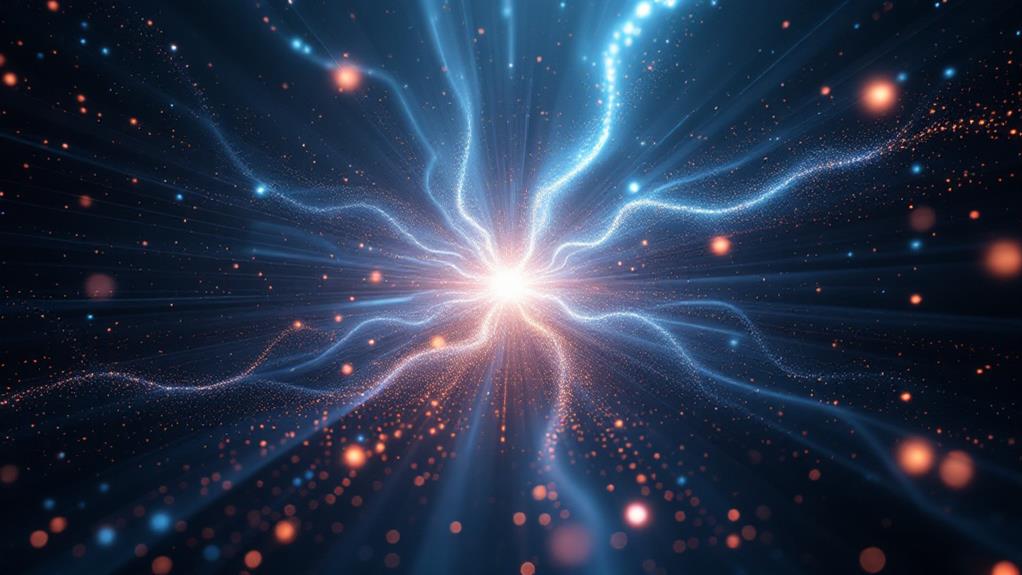Fascinating Theoretical Particles: Exploring the Frontiers of Particle Physics

You'll investigate a world of mesmerizing theoretical particles as you traverse the frontiers of particle physics. From the elusive graviton, believed to carry gravity, to tachyons that might travel faster than light, these hypothetical entities challenge our understanding of the universe. Axions and sterile neutrinos offer potential explanations for dark matter, while magnetic monopoles could revolutionize electromagnetism. Supersymmetric particles, X and Y bosons, preons, and Majorana fermions expand the horizons of particle theory. Though many remain undetected, these fascinating particles drive scientific curiosity and technological advancements. Venture further to uncover the mysteries that shape our cosmic reality.
The Elusive Graviton
In the domain of particle physics, the graviton stands out as one of the most enigmatic and elusive entities. This hypothetical particle is believed to be the force carrier of gravity, much like photons carry the electromagnetic force. Despite decades of research, scientists haven't directly observed gravitons, making them a tantalizing mystery in quantum physics.
You might wonder why gravitons are so hard to detect. The answer lies in the weakness of gravity compared to other fundamental forces. Gravitons are thought to interact with matter far less frequently than other particles, making them incredibly challenging to isolate in experiments. Additionally, quantum fluctuations in spacetime could potentially mask graviton signatures.
While direct detection remains elusive, indirect evidence for gravitons exists. The observation of gravitational waves, ripples in spacetime caused by massive cosmic events, supports the existence of gravitons. These waves, first detected in 2015, are thought to be composed of gravitons, much like light waves consist of photons. As technology advances, you may witness breakthroughs in graviton research, potentially revolutionizing our understanding of gravity and the universe's fundamental structure.
Tachyons: Faster Than Light
Moving from the domain of gravity to the fringes of physics, we encounter another hypothetical particle: the tachyon. You've likely heard of the universal speed limit—the speed of light—but tachyons challenge this notion. These theoretical particles are believed to travel faster than light, leading to fascinating and perplexing consequences.
The concept of tachyons raises intriguing possibilities and paradoxes:
- Time travel implications: As tachyons move backwards in time from our viewpoint, they could potentially carry information to the past.
- Causality violations: Faster-than-light travel could lead to scenarios where effects precede their causes, challenging our understanding of cause and effect.
- Energy considerations: Tachyons would require infinite energy to slow down to light speed, making their existence questionable within our current comprehension of physics.
While tachyons remain purely theoretical, they've sparked countless debates among physicists. You might wonder why scientists entertain such seemingly impossible ideas. It's because exploring these concepts often leads to new points of view and advancements in our understanding of the universe, even if the original hypothesis proves false.
Axions and Dark Matter

Have you ever wondered about the mysterious substance that makes up most of our universe? Dark matter, invisible and elusive, has puzzled scientists for decades. Enter axions, hypothetical particles that might hold the key to unraveling this cosmic enigma.
Axions are lightweight, neutral particles proposed to solve certain problems in quantum chromodynamics. They've gained attention as potential dark matter candidates due to their predicted properties. Unlike other dark matter particles, axions could be incredibly light, possibly even lighter than neutrinos.
Dark matter detection efforts have traditionally focused on massive particles, but axion searches require different techniques. Scientists use specialized detectors that exploit axions' predicted interactions with electromagnetic fields. These experiments aim to convert axions into detectable photons.
Understanding axion production mechanisms is essential for these searches. Theories suggest axions could have been created in the early universe through various processes, including the misalignment mechanism and the decay of topological defects. By studying these mechanisms, researchers hope to narrow down the possible mass range for axions and improve detection strategies.
Sterile Neutrinos
While axions offer one potential solution to the dark matter puzzle, another intriguing possibility exists in the domain of neutrinos. Enter sterile neutrinos, hypothetical particles that could explain some of the mysteries surrounding neutrino oscillation and serve as dark matter candidates.
Unlike the three known types of neutrinos, sterile neutrinos wouldn't interact via the weak nuclear force. They'd only feel gravity and, potentially, new forces yet to be discovered. This property makes them challenging to detect but also fascinating for physicists.
Sterile neutrinos could help explain several phenomena:
- The missing antimatter in the universe
- The formation of galaxies and large-scale structures
- Anomalies observed in certain neutrino experiments
If they exist, sterile neutrinos might come in different masses. The lightest ones could mix with known neutrinos, affecting oscillation patterns. Heavier versions could be prime dark matter candidates, potentially making up a significant portion of the universe's missing mass.
As you explore deeper into particle physics, you'll find that sterile neutrinos represent just one of many exciting frontiers. Their potential to solve multiple cosmic puzzles makes them an intriguing subject for ongoing research and speculation.
Magnetic Monopoles

From among the many exotic particles theorized in physics, magnetic monopoles stand out as particularly elusive. These hypothetical particles possess a single magnetic pole, either north or south, unlike conventional magnets that always have both poles. The concept of magnetic monopoles has intrigued physicists for decades, as their existence would elegantly explain the quantization of electric charge.
Paul Dirac proposed the magnetic monopole hypothesis in 1931, suggesting that the existence of even a single monopole in the universe would explain why electric charge always comes in discrete units. This idea, known as magnetic charge quantization, has profound implications for our understanding of fundamental physics.
Despite numerous experimental searches, you won't find any conclusive evidence of magnetic monopoles yet. Scientists have looked for them in cosmic rays, particle accelerator experiments, and even moon rocks. Their potential discovery could revolutionize our understanding of electromagnetism and lead to new technological applications. As you explore deeper into particle physics, keep an eye on the ongoing hunt for these enigmatic particles, as they continue to challenge our current models of the universe.
Supersymmetric Particles
Magnetic monopoles aren't the only elusive particles that have captured physicists' imaginations. Supersymmetric particles, or "sparticles," have been a hot topic in theoretical physics for decades. These hypothetical particles are predicted by supersymmetry, a theory that suggests every known particle has a heavier counterpart.
You might wonder why scientists are so interested in these theoretical particles. Three key reasons:
- They could solve the hierarchy problem in particle physics
- They're potential candidates for dark matter
- Their existence would help unify fundamental forces
Despite extensive searches, we haven't found any supersymmetric particles yet. This has led to challenges in the theory, including issues with supertrace anomalies and predictions about superpartner masses. Some physicists argue that the lack of evidence suggests supersymmetry might be incorrect, while others believe we simply haven't reached the energy levels needed to detect these particles.
As you explore deeper into particle physics, you'll find that the search for supersymmetric particles continues to drive research and expand the boundaries of our understanding of the universe.
X and Y Bosons

Moving beyond supersymmetry, we come across another fascinating area of particle physics: X and Y bosons. These hypothetical particles play a pivotal role in theories of gauge boson unification, which aim to combine the fundamental forces of nature into a single, cohesive framework.
X and Y bosons are proposed as heavy gauge bosons that could mediate interactions between the known particles of the Standard Model and a hidden sector of particles. This hidden sector might contain dark matter candidates or other exotic particles that we haven't yet detected. The existence of X and Y bosons could provide valuable clues about some of the mysteries in particle physics, such as the hierarchy problem and the nature of dark matter.
You'll find that these bosons are predicted to have extremely high masses, making them difficult to produce in current particle accelerators. However, their effects might be observable indirectly through precision measurements or rare decay processes. As scientists continue to expand the boundaries of particle physics, the search for X and Y bosons remains an exciting frontier, potentially yielding new perspectives into the fundamental structure of the universe.
Preons: Particle Substructures
Delving deeper into the subatomic domain, we encounter the fascinating concept of preons. These hypothetical particles are proposed as the fundamental building blocks of quarks and leptons, which we've long considered elementary. The preon model suggests that these subatomic particles aren't indivisible but have their own internal structure.
Preon theory aims to simplify the Standard Model by reducing the number of truly fundamental particles. It's crucial to acknowledge that different combinations of preons could explain the variety of known particles and their properties. Preon families might include:
- Color preons: responsible for the strong nuclear force
- Flavor preons: determining particle flavors like up, down, charm, and strange
- Spin preons: accounting for particle spin
Preon interactions are thought to be governed by a new force, much stronger than the strong nuclear force. This hypercolor force would bind preons together to form quarks and leptons. While the preon model is intriguing, it's essential to recognize that there's currently no experimental evidence supporting their existence. The search for preons continues, pushing the boundaries of our understanding of particle physics.
Majorana Fermions

The quest for exotic particles takes us to the domain of Majorana fermions, a unique class of particles that are their own antiparticles. Named after Italian physicist Ettore Majorana, these theoretical particles blur the line between matter and antimatter. Unlike typical fermions, Majorana fermions possess the extraordinary property of being indistinguishable from their counterparts.
You'll find that Majorana fermions have garnered significant attention in condensed matter physics and quantum computing. Scientists are exploring the potential of Majorana Fermi condensates, which could offer viewpoints into exotic states of matter. These condensates might exhibit unique properties that challenge our understanding of particle behavior at the quantum level.
In the sphere of quantum computing, Majorana Fermi qubits present an exciting possibility. These qubits could be more resistant to decoherence, a major obstacle in quantum computation. By utilizing the unique properties of Majorana fermions, researchers hope to develop more stable and efficient quantum computers. While the existence of Majorana fermions remains unconfirmed, ongoing experiments in superconductors and topological materials continue to expand the boundaries of our knowledge in particle physics.



